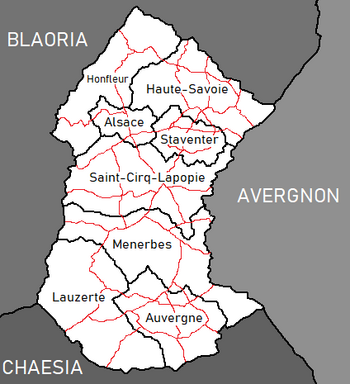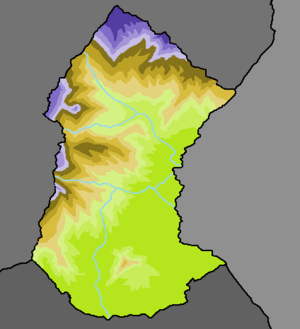Shoassau: Difference between revisions
| Line 146: | Line 146: | ||
===Cuisine=== | ===Cuisine=== | ||
Shoassau's cuisine reflects the country's position between the Drambenburgian and Avergnonian countries, influenced by the cuisines of nearby Zamastan and other smaller countries bordering it. Recently, it has been influenced by the country's many [[East Chanchajilla]]n and [[Paraboca]]n immigrants. Most native Shoassau dishes, consumed as the traditional daily fare, share roots in the country's folk dishes the same as in neighboring Avergnon. | Shoassau's cuisine reflects the country's position between the Drambenburgian and Avergnonian countries, influenced by the cuisines of nearby Zamastan and other smaller countries bordering it. Recently, it has been influenced by the country's many [[East Chanchajilla]]n and [[Paraboca]]n immigrants. Most native Shoassau dishes, consumed as the traditional daily fare, share roots in the country's folk dishes the same as in neighboring Avergnon. | ||
===Sport=== | |||
Skiing, snowboarding and mountaineering are among the most popular sports in Shoassau, the geography of the country being particularly suited for such activities. Football, or soccer, is the most watched sport however, and is widely played throughout Shoassau. The [[Shoassau national football team]] represents the country in international matches such as the [[Olympic Games (Iearth)|Olympic Games]] and the [[World Cup (Iearth)|World Cup]]. Shoassau won the [[1990 Allengin World Cup]], beating [[Zamastan]] 2-1 in the finals. | |||
Automobile racing, specifically Formula racing, is also a popular sport. Shoassau hosts the [[Staventer Grand Prix]] annually, and Shoassauan racers such as [[Emann Belmontue]] compete internationally in events such as the [[Rio Palito Grand Prix]]. | |||
[[Ruedi Griessen]] is widely considered to be the greatest tennis player of all time. Other famous Shoassauan athletes include [[Res Preisig]], [[Nathan Lanicca]], [[Lyan Brassel]], [[Jockel Steuri]], [[Hias Schulthess]], [[Nicolas Karlen]], [[Siad Schmidlin]], [[Beat Hochmuth]], [[Vitus Jakob]], and [[Camilla Hundsberger]]. | |||
===Music=== | ===Music=== | ||
Revision as of 19:49, 20 June 2021
Kingdom of Shoassau Shoassau | |
|---|---|
|
Flag | |
 | |
| Capital | Staventer |
| Official languages | Drambenburgian, Avergnonian |
| Recognised national languages | Shoassauan |
| Government | Unitary parliamentary constitutional monarchy |
• King | Darien IV |
| Gabriel Leitner | |
| Establishment | |
| 929 | |
• Drambenburgian Empire | 1400-1954 |
• Independence | November 19th, 1954 |
| Area | |
• | 41,285 km2 (15,940 sq mi) |
• Water (%) | 3.2% |
| Population | |
• 2020 estimate | 1,211,000 |
| GDP (PPP) | estimate |
• Total | 283 billion |
| GDP (nominal) | estimate |
• Total | 217 billion |
| Gini | 29.7 low |
| HDI | 0.833 very high |
| Currency | Avergnonian dollar |
| Date format | mm-dd-yyyy |
The Republic and Kingdom of Shoassau, most commonly known as Shoassau, is a landlocked nation located on the continent of Euronia in Iearth, bordered by Avergnon, Chaesia, and Blaoria. It is composed of 8 federated states, including the capital and largest city of Staventer, second-largest city Auvergne, and third-largest city Alsace. Shoassau occupies an area of 41,285 km2 (15,940 sq mi) and has a population of 1.2 million people. Drambenburgian and Avergnonian are the country's official languages, but Shoassauan dialects are also spoken extensively.
Shoassau initially emerged as a margraviate around 894 and developed into a duchy and archduchy. In the 15th century, Shoassau was conquered by Drambenburgian kingdoms and started serving as the heart of extensive trading networks in Euronia. It was a major component and administrative centre of the Holy Drambenburgian Empire. Following the defeat of Drambenburg in 1954 at the end of the World War and an extended period of Allied occupation, Shoassau was re-established as a sovereign and self-governing democratic nation known as the Second Republic.
Shoassau is a unitary parliamentary constitutional monarchy, with King Darien IV serving a largely ceremonial role as the head of state, and Prime Minister Gabriel Leitner as the head of government. Shoassau is a member state of the Coalition of Crown Albatross, the Coalition Trade Organization, and many other international agreements.
History
Prehistory
Middle Age
Drambenburgian Empire
World War
Independence
21st Century
On March 31st, 2021, a gunman attacked a shopping center in Auvergne, killing 16 people[1]. Prime Minister Gabriel Leitner and Parliament passed restrictive gun legislation, outlawing most civilian weapons in the country.
Geography
Shoassau is a largely mountainous country because of its location in the Central Euronian Alps. The Central Euronian Alps, Western Bluestone Alps and Southern Bluestone Alps are all partly in Shoassau. Of the total area of Shoassau, about a third can be considered low lying, and only 22% of the country is below 500 metres (1,640 ft). The Alps of western Shoassau give way into low lands and plains in the eastern part of the country.
Climate
Biodiversity
Demographics
Religion
Language
Cities
Politics

The Shoassau Parliament, also known as the Federal Assembly, is the bicameral national legislature of Shoassau. It is comprised of the National Council (the lower house) with 200 representatives and the Senate (the upper house) with 46. Collectively, it operates as the constituted federal government and the head of state, with the Prime Minister exercising the authority above parliamentary elected ministers. The current Prime Minister is Gabriel Leitner.
Elections are held on a national level every four years. The most recent election was in 2017, where the Democratic Party won a majority in the National Assembly and formed a coalition government with the Socialist Party and the National Labor Party, against a minority government of the Conservative Party and the Liberation Party.
The Federal Supreme Court's function is to hear appeals against rulings of cantonal or federal courts. The judges are elected by the Federal Assembly for six-year terms.
Monarchy
The Monarchy of Shoassau is no longer a direct political contributor to the functions of the Shoassau government, and operates largely in a symbolic role of Shoassauan culture. However, the royal family still has an important role in appointment, with ministers who are elected by Parliament needing a final approval from the Monarch. The current King is Darien IV, who has been on the throne since his ascension in 1982.
Military
The Shoassau army is mostly based in its casern, the Centre militaire Caserne in Haute-Savoie. The general staff is based in the capital, Staventer, the État-Major. The army is under civilian control, with the King as Commander-in-Chief. The Minister of Defense, François Belmarc, oversees army operations. The professional head of the army is the Chief of Defense, who answers to the minister and holds the rank of general.
Being a landlocked country, Shoassau has no navy. In accordance with a joint agreement with Avergnon, both countries have put forth funding for one military cargo plane.
The army has participated in humanitarian relief missions such as setting up refugee camps in Jaginistan and providing emergency supplies to Syraranto.
Foreign Relations
Shoassau has long been a prominent supporter of Euronian political and economic integration. In 1959, Shoassau and Avergnon formed the Avergnon–Shoassau Economic Union (ASEU) to create a regime of inter-exchangeable currency and a common customs.
Shoassau is a member of the Coalition of Crown Albatross, as well as other international organizations like the Coalition Trade Organization.
Culture
Art
Literature
Cuisine
Shoassau's cuisine reflects the country's position between the Drambenburgian and Avergnonian countries, influenced by the cuisines of nearby Zamastan and other smaller countries bordering it. Recently, it has been influenced by the country's many East Chanchajillan and Parabocan immigrants. Most native Shoassau dishes, consumed as the traditional daily fare, share roots in the country's folk dishes the same as in neighboring Avergnon.
Sport
Skiing, snowboarding and mountaineering are among the most popular sports in Shoassau, the geography of the country being particularly suited for such activities. Football, or soccer, is the most watched sport however, and is widely played throughout Shoassau. The Shoassau national football team represents the country in international matches such as the Olympic Games and the World Cup. Shoassau won the 1990 Allengin World Cup, beating Zamastan 2-1 in the finals.
Automobile racing, specifically Formula racing, is also a popular sport. Shoassau hosts the Staventer Grand Prix annually, and Shoassauan racers such as Emann Belmontue compete internationally in events such as the Rio Palito Grand Prix.
Ruedi Griessen is widely considered to be the greatest tennis player of all time. Other famous Shoassauan athletes include Res Preisig, Nathan Lanicca, Lyan Brassel, Jockel Steuri, Hias Schulthess, Nicolas Karlen, Siad Schmidlin, Beat Hochmuth, Vitus Jakob, and Camilla Hundsberger.
Music
Media
Economy
Shoassau's stable and high-income market economy features moderate growth, low inflation, and a high level of innovation. Unemployment is traditionally low, although it had risen to 6.1% by May 2012, due largely to the effect of the 2008 Euronia financial crisis.
The industrial sector, which was dominated by steel until the 1960s, has since diversified to include chemicals, rubber, and other products. During the past decades, growth in the financial sector has more than compensated for the decline in steel production. Services, especially banking and finance, account for the majority of the economic output. Shoassau is among the world's largest investment fund centers, the most important private banking center in Euronia and is one of the continent's leading centers for reinsurance companies. Moreover, the Shoassau government has aimed to attract Internet startups.
Telecommunications
Transport

Shoassau has road, rail and air transport facilities and services. The road network has been significantly modernized in recent years with 147 km (91 mi) of motorways connecting the capital to adjacent countries. The advent of the high-speed TGV link to Vessalia has led to renovation of the city's railway station and a new passenger terminal at Shoassau International Airport was opened in 2008. Staventer reintroduced trams in December 2017 and there are plans to open light-rail lines in adjacent areas within the next few years.
The number of cars per 1000 persons amount to 680.1 in Shoassau — higher than all but two states, namely Lutharia and the island nation of Janapa.
On 29 February 2020, Shoassau became the first country to introduce no-charge public transportation which will be almost completely funded through tax revenue.




